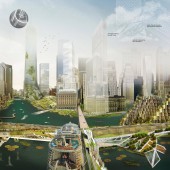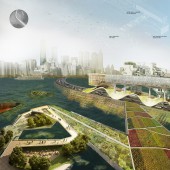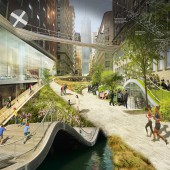
| THE AWARD |
| CATEGORIES |
| REGISTRATION |
| SUBMIT YOUR WORK |
| ENTRY INSTRUCTIONS |
| TERMS & CONDITIONS |
| PUBLICATIONS |
| DATES & FEES |
| METHODOLOGY |
| CONTACT |
| WINNERS |
| PRESS ROOM |
| GET INVOLVED |
| DESIGN PRIZE |
| DESIGN STORE |
| THE AWARD | JURY | CATEGORIES | REGISTRATION | PRESS | WINNERS | PUBLICATIONS | ENTRY INSTRUCTIONS |
Nyc 2050 City Masterplan by Walmir Luz |
Home > Winners > Design #44424 >Interview |
 |
|
FS: What is the main principle, idea and inspiration behind your design?
WL: The main idea was to reimagine how to redesign New York making water a part of the urban life. A city that embraces the flood and other environmental issues of the present time and uses them as a solution to other problems.
FS: What has been your main focus in designing this work? Especially what did you want to achieve?
WL: The focus of this masterplan was to show how New York can once again reshape its edge and readapt itself at the same time that it maintains its vitality and urban qualities of nowadays while embracing/protecting itself from the sea level rise, storm surges and future floods.
FS: What are your future plans for this award winning design?
WL: I’m currently compiling all the research that I have done so far and expanding it a little bit further so to create a book that deeply explores and discuss the possibilities introduced by this proposal.
FS: How long did it take you to design this particular concept?
WL: This concept was a 4-month work going back and forth between design and research.
FS: Why did you design this particular concept? Was this design commissioned or did you decide to pursuit an inspiration?
WL: I have always been intrigued about how cities will be shaped in the future when they are forced to face the consequences of present environmental issues. With that in mind, I decided to take NYC, one of the most important cities in the world, and design its future as part of my thesis to conclude my 5-year architecture program at Cornell University.
FS: Is your design being produced or used by another company, or do you plan to sell or lease the production rights or do you intent to produce your work yourself?
WL: This proposal is more of a city utopia/dystopia, whatever we may define it and I see it as a case study for our future.
FS: What made you design this particular type of work?
WL: Society is currently living at the edge of big changes. Environmental issues have been ignored for a long time and they are still being somehow ignored. At some point, there will be a breakpoint.
FS: Where there any other designs and/or designers that helped the influence the design of your work?
WL: There are plenty of masterplan proposals for NYC created by innumerous architects and they all have relevant and interesting ideas. ARO, Bjarke Ingels, SCAPE and many others have introduced unique ideas and interventions on how to deal with similar problems.
FS: Who is the target customer for his design?
WL: There is not a customer in mind since this is more of a future masterplan but it can be used as a way to start a discussion about future cities; about future societies.
FS: What sets this design apart from other similar or resembling concepts?
WL: As I said before, there are lots of proposals on how to intervene on NYC. They all have great ideas that inspired and even helped on the creation of mine but the biggest difference is that most of them are still trying to stop the sea level rise instead of embracing it as I have done.
FS: How did you come up with the name for this design? What does it mean?
WL: I studied many NYC climate predictions up to the year of 2100. As I started to design and define my goal to redefine Manhattan by 2050. It became the NYC 2050.
FS: Which design tools did you use when you were working on this project?
WL: Diagrams, hand sketches, study models, digital models and collages.
FS: What is the most unique aspect of your design?
WL: An optimistic vision of how NYC can embrace an environmental issue and incorporate it as a way to introduce a better urban life!
FS: Who did you collaborate with for this design? Did you work with people with technical / specialized skills?
WL: This was my thesis for the conclusion of the B.Arch program at Cornell University and I had Professor Andrea Simitch and Professor Arthur Ovaska as my thesis advisors.
FS: What is the role of technology in this particular design?
WL: Technology has and will always be an important element for any society’s development, therefore, it will be critical to the development of such future masterplan.
FS: Is your design influenced by data or analytical research in any way? What kind of research did you conduct for making this design?
WL: The masterplan was conceptualized by studying the history of Manhattan's edge, the climate crisis predictions by the United States Landfalling Hurricane Probability Project, and several climate studies produced by the NASA Goddard Institute for Space Studies.
FS: What are some of the challenges you faced during the design/realization of your concept?
WL: The challenge was to create a visionary design thinking outside of the box but at the same time, maintaining a level of reality which makes the project possible to pursue.
FS: How did you decide to submit your design to an international design competition?
WL: I believe I took a unique approach going against the safe method of trying to save the city. In a way, the project is indeed saving the city by accepting the catastrophe. It is an optimistic way of compromising in favor of survival. Thus, I think it is worth sharing so to initiate a new kind of conversation about our future.
FS: What did you learn or how did you improve yourself during the designing of this work?
WL: On this particular project, a big lesson that I am going to take with me is that not every problem needs to be a problem. Problems can be solutions! It is just a matter of perspectives.
FS: Thank you for providing us with this opportunity to interview you.
A' Design Award and Competitions grants rights to press members and bloggers to use parts of this interview. This interview is provided as it is; DesignPRWire and A' Design Award and Competitions cannot be held responsible for the answers given by participating designers.
| SOCIAL |
| + Add to Likes / Favorites | Send to My Email | Comment | View Press-Release |





